Exploring the Sheikh Mohammed bin Rashid Tower in Dubai
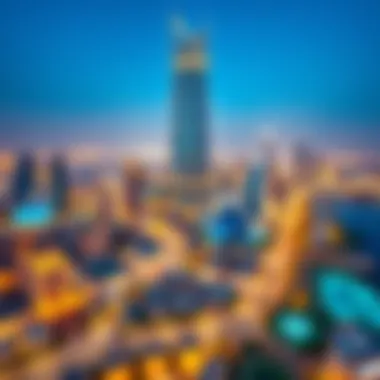
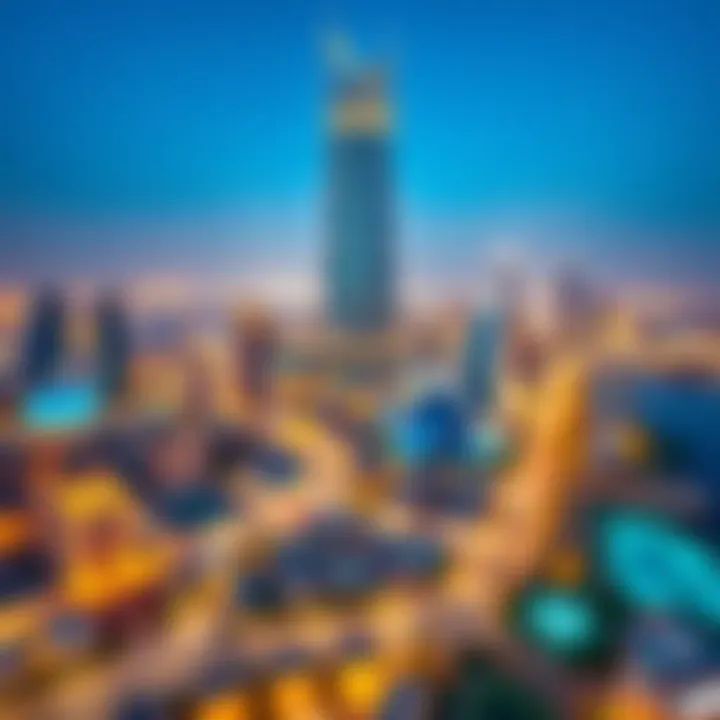
Intro
The Sheikh Mohammed bin Rashid Tower stands tall as a defining landmark in Dubai, merging modern architectural ingenuity with the rich cultural heritage of the emirate. This tower not only enhances the skyline but also legitimizes Dubai's ambition as a global leader in luxurious living and progressive urban design. As one stands at the base and gazes upwards, it's evident that this structure acts like a beacon, guiding economic growth and tourism. But what lies beneath the striking façade?
Before diving into its architectural marvels and the lavish amenities it houses, understanding the context in which this tower was built is vital. This exploration considers not just the physical structure, but also its significance in the ever-evolving landscape of Dubai's real estate market.
In a realm where ambition meets reality, we will examine how this tower influences property trends, and investment potential, and even reflects the fast-paced economic shifts of the region. As Dubai continues to attract both domestic and foreign investments, let's unpack the layers of significance that the Sheikh Mohammed bin Rashid Tower encapsulates, setting the stage for a deeper conversation about its role in the contemporary real estate sphere.
Prolusion
The Sheikh Mohammed bin Rashid Tower stands tall as a testament to Dubai’s remarkable evolution and ambition. This article explores not only the architectural splendor of the tower but also its role in reshaping the city’s skyline and boosting its economy. Moreover, it's essential to understand how such landmarks impact the perceptions and decisions of investors in the bustling real estate market of Dubai.
As we delve deeper, we'll examine various aspects that resonate with a diverse audience— from potential homebuyers to experienced investment professionals. The backdrop of rapid urban development and soaring property values plays a pivotal role in this discussion. The significance of the Sheikh Mohammed bin Rashid Tower emerges as pivotal in attracting both local and international attention.
This introduction sets the stage for a comprehensive exploration of the tower’s architectural design, its historical context, and the economic influence it wields in Dubai’s real estate scene. By providing nuanced insights, we aim to highlight the investment potential that this iconic structure represents. Investors and stakeholders should keep a keen eye on this marvel as it unfolds into a major player in the ever-competitive landscape of real estate.
"The tower is not just a building; it's a statement of ambition and ingenuity."
In the following sections, we’ll unpack how these elements weave together to create an intricate narrative around the Sheikh Mohammed bin Rashid Tower. From its construction timeline to the amenities it offers, each piece contributes to understanding why this landmark is indeed a pinnacle of Dubai's skyline.
Architectural Design
Architectural design is more than mere aesthetics; it embodies functionality, innovation, and a reflection of cultural values. In the context of the Sheikh Mohammed bin Rashid Tower, the architectural design is pivotal in showcasing Dubai's ambition to push boundaries within the realms of modernity and tradition. The tower is not just a structure but a statement, symbolizing the city's unwavering desire to remain at the forefront of global architecture.
Design Philosophy and Inspiration
The inspiration behind the Sheikh Mohammed bin Rashid Tower is a blend of historical significance and modern aspirations. Drawing from the rich traditions of Arabian architecture, the design incorporates elements that resonate with the local environment while embracing contemporary techniques. The smooth silhouette of the tower mirrors the curves found in natural formations, suggesting a sense of harmony with its surroundings.
One can argue that the design philosophy is anchored in the principle of sustainability, aiming to minimize environmental impact while maximizing energy efficiency. The incorporation of advanced technology enables the building to adapt to the harsh climate conditions of Dubai, integrating features such as:*
- Solar panels
- Energy-efficient systems
- Heat-reducing glass
These elements not only enhance aesthetics but also reflect a commitment to responsible development practices, crucial in today’s context.
"Architecture is the art of how to waste space" – Philip Johnson
The interplay of light and shadow throughout different times of the day adds an ethereal quality to the tower, encouraging onlookers to appreciate its changing form. This innovative approach to design ensures that the Sheikh Mohammed bin Rashid Tower is not only visually striking but also functionally exceptional.
Structural Features
The structural sophistication of the Sheikh Mohammed bin Rashid Tower is a testament to modern engineering. As one gazes up at its towering presence, one cannot help but notice the meticulous details that demonstrate advanced construction methodologies. The structural core, designed for both strength and flexibility, allows the building to withstand high winds and seismic activities. This resilience is particularly vital given the tower's significant height and urban location.
The choice of materials reflects a modern outlook. Reinforced concrete and high-grade steel are utilized extensively, ensuring durability while maintaining aesthetic appeal. The use of glass, particularly in the facade, offers panoramic views of the expansive Dubai skyline, enhancing the overall experience for occupants and visitors alike. Here are a few of the key structural features that set the tower apart:
- Wind Load Resistance: Designed to withstand wind pressures, thus ensuring safety and stability.
- High-Performance Facade: The glass facade enhances insulation and reflects the sun, contributing to energy efficiency.
- Smart Building Technology: Integrating automation for lighting, heating, and cooling to allow for customizable environments.
In summary, the architectural design of the Sheikh Mohammed bin Rashid Tower stands as a reflection of Dubai’s ambition—melding functionality with innovative aesthetics. Its design philosophy rooted in cultural significance paired with modern sustainability practices and fortified structural elements makes the tower an iconic representation of the emirate's ethos.
Historical Context
Understanding the historical context of the Sheikh Mohammed bin Rashid Tower not only sheds light on its architectural legacy but also showcases its pivotal role in Dubai's urban narrative. The tower, standing tall in the heart of a city known for its rapid growth and transformation, encapsulates a period of aggressive development fueled by vision and ambition. Investing time to understand this context reveals deeper insights into the socio-economic dynamics that shaped the emirate into what it is today.
Development Timeline
The development timeline of the Sheikh Mohammed bin Rashid Tower traces back to the early 2000s when Dubai was embarking on a journey of architectural reinvention. Initial plans started in 2003, coinciding with Dubai's overall strategy to diversify its economy away from oil dependency.
- 2003-2005: Conceptual designs were proposed, reflecting both the aspirations of the emirate and the growing demand for high-end commercial and residential spaces.
- 2006: Construction officially began. The project was part of larger initiatives, including the Burj Khalifa and other landmarks, that led to an overarching goal of redefining Dubai’s skyline.
- 2009: The tower's structure reached significant milestones as the framework took shape, marking a tangible representation of Dubai’s ambitious leap into modernity.
- 2012: Grand opening of the Sheikh Mohammed bin Rashid Tower, showcasing a blend of cutting-edge technology and refined luxury.
This timeline not only provides a chronological view of its development but also contextualizes the tower within broader economic trends, such as increased tourism and foreign investment that Dubai experienced during this period.
Cultural Significance
Culturally, the Sheikh Mohammed bin Rashid Tower stands as a beacon of innovation, spotlighting the rich tapestry of Dubai's history and its aspirations for the future. Its architectural design reflects not only modern aesthetics but also incorporates elements reminiscent of traditional Middle Eastern architecture, establishing a dialogue between the past and present.
The tower serves multiple cultural functions:
- It is a symbol of national pride, representing the achievements of the United Arab Emirates.
- The design elements draw inspiration from Islamic motifs, which fosters a connection to the region's heritage while embracing modernity.
- Hosting various art exhibitions and cultural events, the tower has grown into a hub of community engagement, further embedding it within the cultural fabric of the city.
“The Sheikh Mohammed bin Rashid Tower isn’t just about reaching new heights; it’s about elevating the community and culture it represents.”
For investors and cultural enthusiasts alike, understanding the tower's historical framework and cultural significance is key to recognizing its profound impact on both the local identity and the global perception of Dubai. This intricate web of history, architecture, and culture exemplifies how the Sheikh Mohammed bin Rashid Tower isn't merely a structure but a powerful symbol of progress and heritage.
Economic Impact
The economic impact of the Sheikh Mohammed bin Rashid Tower extends beyond mere aesthetics; it plays a pivotal role in shaping Dubai's financial landscape and elevating its status as a global business hub. This section will delve into two significant facets: the role of the tower in Dubai's real estate market and its influence on property prices.
Role in Dubai's Real Estate Market
The Sheikh Mohammed bin Rashid Tower stands as a robust indicator of Dubai's thriving real estate sector. Unlike many architectural feats that serve only as landmarks, this tower embodies investment and opportunity. Its strategic location adjacent to key business districts enhances its value, making it a desirable destination for both buyers and lessees. The tower's mix of residential and commercial spaces attracts a diverse group of tenants, bolstering the market's liquidity and stability.
When discussing its role, one cannot overlook the ripple effect it has on surrounding developments. As the tower garners international attention, nearby properties often see increased interest. Investors are drawn not only to the tower itself but also to the potential for enhanced community value, making the area ripe for financial growth. Developers may begin new projects, spurred by the success and visibility of the tower, thereby furthering Dubai's ambition to be a world-class city.
Moreover, the tower serves as a landmark representing the boldness and innovation of Dubai's real estate aspirations. New projects and initiatives often spring from such iconic structures, inspiring investors and ‘up-and-coming’ developers to delve into high-rise constructions and urban planning endeavors.
Influence on Property Prices
The impact of the Sheikh Mohammed bin Rashid Tower on property prices in Dubai is profound and multifaceted. As a prestigious residential and commercial address, demand for properties in close proximity to the tower surges, resulting in price escalations that reflect desirability.
- Increased Demand: With the rise in popularity of living near the tower, the demand for residential properties has gone up tremendously. This trend is especially prevalent among expatriates and local professionals seeking proximity to their workplaces, social hubs, and leisure activities.
- Price Premiums: Properties within a certain radius of the Sheikh Mohammed bin Rashid Tower often command a price premium compared to other areas in Dubai. This premium is a direct reflection of the tower’s status and the amenities that come with living in such a landmark structure.
- Market Sentiment: The real estate market's overall sentiment experiences a boost when iconic buildings are completed. A thriving rental market correlates with rising average sale prices, enhancing the perception that investing in property near the tower is a lucrative decision.
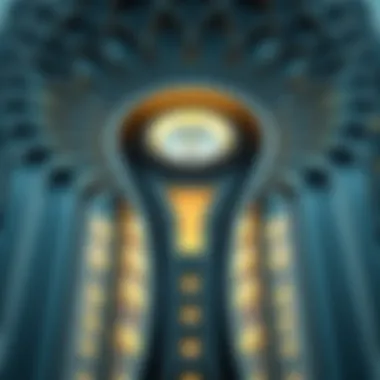
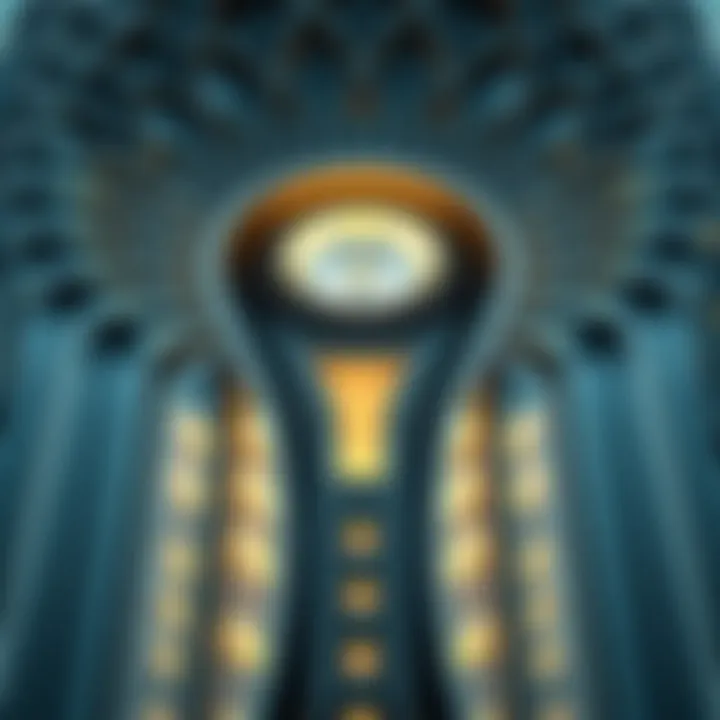
"The Sheikh Mohammed bin Rashid Tower isn’t just a building; it’s a catalyst for economic growth in the region, creating real value for both residents and investors."
Amenities and Services
The Sheikh Mohammed bin Rashid Tower stands not only as a marvel of engineering but also as a residential and commercial haven. The amenities and services within its walls play a crucial role in enhancing the overall experience for both residents and visitors. These facilities are not merely utilities; they represent a lifestyle choice, reflecting the aspirations of those who call this tower home or conduct their business from its offices. With such a rich array of offerings, understanding these amenities provides deeper insights into the value of the tower itself.
Residential Amenities
Living at the Sheikh Mohammed bin Rashid Tower is far more than just occupying a space; it is about embracing a lifestyle defined by luxury and comfort. Each residential unit has been meticulously crafted to ensure that residents enjoy the pinnacle of convenience, aesthetics, and functionality.
- Modern Interiors: Each apartment showcases contemporary design, with large windows that let in natural light and high-quality finishes that attract discerning renters and buyers. The layouts evoke openness, which is crucial for that comfortable living feel.
- Recreational Facilities: The tower boasts an array of recreational amenities that include swimming pools, fitness centers, and landscaped gardens. These spaces foster community engagement, making it easy for neighbors to connect while also offering residents their slice of tranquility amidst urban life.
- Security and Management: A significant part of any residential property is the safety it provides. At Sheikh Mohammed bin Rashid Tower, 24/7 security and professional management services ensure that residents enjoy peace of mind. This element alone can drive up property desirability among potential buyers and renters.
Moving into this stack of luxury isn’t just about flair. It is a complete package meant to enhance the everyday living experience.
Commercial Spaces
The commercial aspect of the Sheikh Mohammed bin Rashid Tower presents a blend of opportunity and prestige that can attract a diverse range of businesses. The tower's strategic positioning within Dubai's bustling economy ensures that these spaces are not only well-placed but also highly sought after.
- Flexible Workspaces: Designed to accommodate various business needs, the office spaces range from private suites to open plan areas. This flexibility allows companies—whether startups or established enterprises—to tailor their environments for maximum productivity and employee satisfaction.
- Business Amenities: The commercial sector of the tower includes meeting rooms equipped with state-of-the-art technology, high-speed internet, and concierge services to assist businesses with administrative tasks. High-profile clients and partners will surely appreciate the professionalism reflected in such services.
- Proximity to Key Locations: Located within a vibrant district, businesses in the Sheikh Mohammed bin Rashid Tower benefit from proximity to transport links, nearby amenities, and the allure of being part of an iconic building. This aspect alone can significantly enhance a company’s image and visibility.
Embarking on a business journey within the Sheikh Mohammed bin Rashid Tower can unlock layers of potential, making it a desirable choice for entrepreneurs and investors alike.
"The amenities and services at the Sheikh Mohammed bin Rashid Tower are designed to not only meet but anticipate the needs of its residents and businesses, ensuring a standard of living and working that is truly exceptional."
For more insights on real estate trends and investment opportunities, you can visit Wikipedia or explore additional resources on Britannica.
You may also check community discussions on Reddit or engage with experts via Facebook.
These resources can broaden your understanding of this dynamic property market.
Real Estate Trends
Understanding the real estate trends around the Sheikh Mohammed bin Rashid Tower is crucial for anyone involved in property investment, be it buyers, homeowners, or real estate agents. The dynamic landscape of Dubai's real estate market can provide valuable insights into the opportunities and challenges that surround this iconic structure. By analyzing trends, stakeholders can make informed decisions that align with the broader economic environment and local demands.
Current Market Analysis
The Dubai property market has seen a complex tapestry of activity surrounding the Sheikh Mohammed bin Rashid Tower. Currently, demand continues to be robust, driven by a mix of local interest and expatriate investment. As one would expect in a city that’s constantly evolving, prices can swing like a pendulum; however, this particular area has demonstrated resilience.
Some key points to consider in the current market include:
- Demand for Luxury Living: As one of Dubai's skyscrapers that offers both residential and commercial spaces, it has attracted affluent buyers interested in luxury amenities.
- Diverse Population of Residents: The tower has attracted diverse demographics, from young professionals to families, thereby stabilizing rental rates and property values.
- Government Incentives: The UAE government has introduced various incentives for foreign investors, making the market even more attractive.
Recent stats show that rental prices have shown a modest increase, and with recent developments nearby, it is clear that investors should keep a keen eye on emerging trends. Buyers are finding that investing in residential units here can yield fruitful returns. Consider the following factors:
- Proximity to transportation links, enhancing the area’s accessibility.
- High occupancy rates, signaling strong demand for living spaces by both expatriates and locals.
"In real estate, it’s not just about bricks and mortar; it’s about location, investments, and future growth."
Forecast for Future Development
Looking down the road, several opportunities lie ahead for investors considering the Sheikh Mohammed bin Rashid Tower. The area is marked for further development as part of Dubai’s ambitious urban planning. With the Dubai 2040 Urban Master Plan in the pipeline, which aims to enhance the city’s land use and spur economic growth, the implications for real estate are significant.
Here are some forecasts:
- Continued Infrastructure Improvements: Upgrades to public transport, roads, and utilities can be expected, which should enhance property desirability.
- Rise of Mixed-Use Developments: The trend toward integrated living spaces—combining dining, retail, and residential—will likely unfold here, making it more attractive.
- Increased International Interest: As Dubai maintains its reputation as a global city, the influx of foreign investors is anticipated to grow, thus solidifying property values.
- Green Initiatives and Sustainability: As the emphasis on sustainability strengthens, future developments may incorporate green technologies, appealing to environmentally-conscious residents and investors alike.
Investment Opportunities
Investment in real estate has always been a significant component of financial growth and wealth-building strategies across the globe. Within the context of Dubai, Sheikh Mohammed bin Rashid Tower presents a pivotal opportunity that savvy investors should carefully consider. This section will unravel the multi-faceted advantages of investing in this iconic structure while also touching upon the elements that can shape investment decisions.
Target Market for Investors
Sheikh Mohammed bin Rashid Tower, situated prominently in Dubai's skyline, appeals to a diverse array of potential investors. The tower's unique architectural design and the premium location grant it an allure that attracts several target segments:
- High-Net-Worth Individuals (HNWIs): Many wealthy buyers look to acquire residential and commercial spaces in prestigious locations such as this tower. The area’s flourishing business climate combines luxury living with professional convenience, making it highly appealing for HNWIs.
- International Investors: Investors from different corners of the world view Dubai as a stable and prosperous market. With the emirate's continuous and robust economic growth, the tower stands out as a beacon for those seeking secure offshore investments.
- Middle-Class Homebuyers: The emergence of various amenities and lifestyle options makes the tower an attractive choice for middle-class residents. Access to modern facilities and a vibrant community can tempt this segment looking for a well-balanced life.
The blend of these target markets creates a competitive yet rewarding atmosphere for investment, driving demand and fostering a growth trajectory in value.
Potential Returns on Investment
Investing in real estate, particularly at Sheikh Mohammed bin Rashid Tower, can yield promising returns over time. Multiple factors contribute to the investment potential:
- Appreciation: As Dubai continues to evolve into a global hub for trade and tourism, properties within its prime locations are going through steady appreciation. Historical data indicates that real estate values in core areas have seen consistent upward trajectories, making it a wise long-term investment.
- Rental Yields: This tower’s amenities and prestige allow it to command higher rental prices. Investors can expect strong rental yields, especially as the demand for well-located accommodations rises. This could lead to lucrative streams of passive income for property owners.
- Diverse Use Cases: The tower caters to various purposes — residential, corporate, and commercial. This adaptability can lead to more opportunities for monetizing the space and diversifying revenue streams.
Challenges and Considerations
In any significant real estate venture, navigating the turbulent waters of market dynamics is crucial. The Sheikh Mohammed bin Rashid Tower, while being a beacon of architectural excellence in Dubai, also presents a host of challenges and considerations for prospective investors and stakeholders. Understanding these factors is essential, as they play a pivotal role in both immediate and long-term decision making in this arena.
Market Volatility
Market volatility refers to the frequency of price movements in the real estate space. In Dubai, where the real estate sector has seen its fair share of ups and downs, investors must pay close attention to this aspect. Fluctuations can be influenced by various external factors such as global economic trends, changes in local laws, or shifts in demand driven by tourist influx or population growth.
As an illustration, during the oil price downturn in recent years, Dubai's property market experienced a noticeable dip. This kind of volatility poses a risk to potential investors who may find that their properties do not appreciate as expected or may even decrease in value. Thus, it is imperative to conduct thorough market research, assess historical trends, and keep an ear to the ground for any indicators that could signal an impending shift.
Moreover, the high-profile nature of the Sheikh Mohammed bin Rashid Tower may offer some protection against these fluctuations, but it doesn't make it immune. Investors should ask themselves:
- What are the historical price movements in the surrounding market?
- How have recent events affected interest in high-end properties?
- Are there any emerging sectors within Dubai that could shift demand away?
By contemplating these questions, investors can better arm themselves against the caprices of the market.
Regulatory Environment
The regulatory environment is another cornerstone that dictates how both residential and commercial properties are managed within Dubai. Regulations can govern everything from property ownership rights to the responsibilities of landlords and tenants. In Dubai, the real estate regulatory framework has evolved tremendously over the years, as the government strives to streamline processes and attract foreign investments.
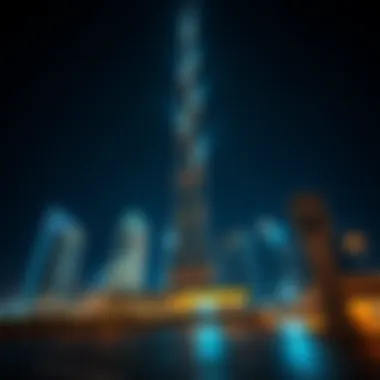
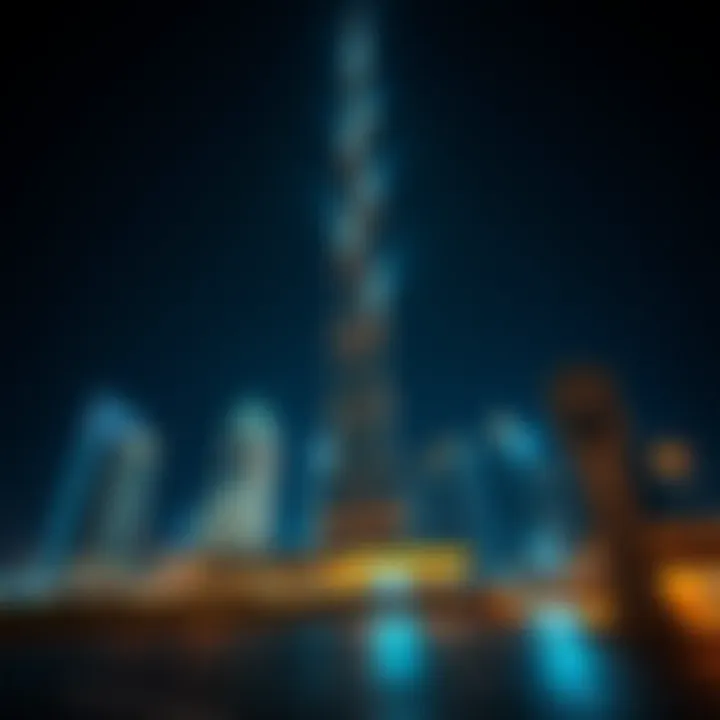
For instance, in recent years, policies have been modified to offer more flexible payment plans for buyers and improved facilities for property registrations. However, with these laws come responsibilities and compliance requirements. There could be additional fees or taxes that would affect the attractiveness of investing in properties like the Sheikh Mohammed bin Rashid Tower.
Understanding local regulations is vital for ensuring a smooth investment experience. Key considerations include:
- What are the implications of foreign ownership in real estate?
- Are there any special assessments or taxes specific to luxury properties?
- How does the regulatory landscape affect tenant rights and rental agreements?
Taking time to familiarize oneself with these legalities can make the difference between a profitable investment and a potential financial pitfall. Ignorance is not bliss in the world of real estate, particularly when dealing with a prestigious structure like the Sheikh Mohammed bin Rashid Tower.
"Investors who ignore the regulations may find themselves in murky waters, often grappling with unexpected legal repercussions."
In essence, while the Sheikh Mohammed bin Rashid Tower offers myriad opportunities, understanding the challenges and considerations tied to market volatility and regulatory frameworks is paramount in navigating the investment landscape effectively.
Lifestyle and Community
The Sheikh Mohammed bin Rashid Tower stands not merely as an architectural feat but as a beacon for a cohesive lifestyle and an engaging community. Its presence in Dubai's skyline speaks volumes about the lifestyle it promotes, which is one characterized by a blend of luxury, comfort, and diversity. Living in such a prominent structure reshapes the way individuals experience urban life, presenting them with opportunities that go beyond the ordinary. By examining the nuances of life at the tower, one can see how it cultivates a unique sense of belonging, while reinforcing community ties.
Living at Sheikh Mohammed bin Rashid Tower
Residing at Sheikh Mohammed bin Rashid Tower offers a unique combination of modernity and comfort, where every inch seems designed with the resident's needs and aspirations in mind. The apartments, ranging from stylish studios to lavish penthouses, offer stunning views of the Dubai skyline, ensuring that natural light fills every room. With advanced home automation systems integrated into residences, effortlessly controlling your environment becomes second nature.
Beyond the physical structure, the lifestyle here is punctuated by convenience. Residents enjoy proximity to essential services, including gourmet dining options and high-end retail shops right on their doorstep. Easy access to recreational spaces boosts the quality of life, allowing for leisurely strolls along beautifully landscaped pathways or relaxation in serene parks nearby.
Community and connectivity thrive in this setting. Social spaces, including lounges and outdoor terraces, create environments conducive to meeting neighbors and fostering new friendships. It's a microcosm where every resident can find a niche—whether they are young professionals or families—cultivating a balanced blend of social interaction and personal privacy.
Community Engagement Activities
The heart of any vibrant community is its engagement activities, and at Sheikh Mohammed bin Rashid Tower, the vibrancy is palpable. A systematic approach to community building sets the stage for a range of events that cater to diverse interests.
- Regular cultural festivals and markets aim to celebrate the richness of Dubai's heritage, integrating art, music, and culinary experiences.
- Fitness and wellness initiatives encourage healthy living, with organized yoga classes and community sports leagues making it easy for residents to come together while staying active.
- Workshops and seminars on various topics, from sustainability to professional development, not only serve to educate but also forge connections among residents who share similar goals.
"Engagement activities, far from being mere gatherings, serve as pillars that uphold the sense of community at Sheikh Mohammed bin Rashid Tower, fostering relationships and creating lasting memories."
Ultimately, the mesh of lifestyle and community practices sets Sheikh Mohammed bin Rashid Tower apart from other residential options. Each resident isn't just a number but a valued part of a larger tapestry, creating a unique narrative that extends beyond their front door. The blend of high-end living with active community participation makes it a prime residence for individuals looking to invest in a fulfilling lifestyle.
Sustainability Practices
Sustainability in architecture and urban planning is pivotal in today’s environmental landscape. In the context of Sheikh Mohammed bin Rashid Tower, various sustainability practices play a crucial role in enhancing the building's efficiency and minimizing its ecological footprint. This section delves into the importance of these practices and their implementation in this iconic structure.
One of the main highlights of sustainability practices within the tower is the use of green building initiatives. These initiatives primarily focus on energy efficiency, water conservation, and overall environmental impacts. They are more than just a trend; they are necessities in maintaining a sustainable future.
Green Building Initiatives
The Sheikh Mohammed bin Rashid Tower employs numerous green building initiatives that set a benchmark for skyscrapers in the region. In particular, the following elements stand out:
- Energy-Efficient Systems: The incorporation of advanced HVAC (Heating, Ventilation, and Air Conditioning) systems does wonders in optimizing energy consumption. This means not only lower utility bills for residents and businesses but also a significant reduction in greenhouse gas emissions.
- Water Management Systems: Efficient water usage is critical, especially in a desert environment. The building employs systems that recycle and treat wastewater for various uses, reducing overall water demand. This can be reflected in strategies such as rainwater harvesting, which collects runoff during rainfall for irrigation and other non-potable uses.
- Sustainable Materials: The materials used in constructing the tower are sourced with sustainability in mind. This includes low-VOC (Volatile Organic Compound) materials that improve indoor air quality as well as materials sourced from local suppliers, which cut down on transportation emissions.
- Green Roof and Vertical Gardens: Features such as a green roof or vertical gardens are vital for improving air quality, reducing urban heat, and providing insulation. Such spaces offer not just aesthetic appeal but also create habitats for local wildlife, enhancing biodiversity within the urban environment.
"Incorporating sustainability practices is no longer optional but essential for future developments if cities want to thrive."
The benefits of these initiatives extend beyond just regulatory compliance. The economic advantages are considerable. Buildings designed with sustainability in mind typically have higher market value and attract environmentally conscious tenants.
Furthermore, from a social perspective, introducing sustainable elements into a community fosters a greater awareness among residents. When individuals live in environments that prioritize sustainability, they often adopt similar habits in their own lives, contributing positively to the larger community.
However, while pursuing sustainability, considerations must be made regarding initial costs and the long-term vision for building maintenance. These practices require investment upfront but can lead to significant savings and improved quality of life over time. Investors looking at the Sheikh Mohammed bin Rashid Tower will find that its dedication to sustainability not only aligns with global trends but also positions it as a responsible and forward-thinking option in today’s market.
Tourism and Visitor Impact
Tourism is a cornerstone of Dubai's economy, and the Sheikh Mohammed bin Rashid Tower plays an integral role in attracting visitors to this vibrant city. As a symbol of modern architectural prowess, the tower not only shapes the skyline but also draws a significant number of tourists eager to experience its beauty and the luxury it represents. The interplay between sightseeing and the broader economic picture is crucial for understanding the impact of this landmark on the tourism industry.
Attraction to Tourists
The Sheikh Mohammed bin Rashid Tower stands as a beacon of innovation and reflects the rich cultural tapestry of Dubai. Tourists flock here, captivated by its towering height and striking design. Each year, millions visit not only to capture that perfect photograph but also to explore the surrounding areas that buzz with life and luxury.
Some of the key factors that make this tower a tourist magnet include:
- Stunning Architecture: The design blends contemporary elements with traditional styles, appealing to a diverse audience.
- Panoramic Views: Observation decks provide breathtaking views of the Dubai skyline and beyond, with many eager to take it all in from above.
- Proximity to Other Attractions: Located near shopping malls, art galleries, and cultural hotspots, it serves as a central hub in a tourist's itinerary.
- Luxury Experience: Many high-end experiences, from upscale dining to exclusive shopping, are available in and around the tower, further amplifying its allure.
According to Dubai's Department of Tourism, attractions like the Sheikh Mohammed bin Rashid Tower contribute significantly to the overall number of visitors, making it both a pivotal landmark and an economic driver.
"The architectural splendor of the tower is matched only by the myriad opportunities for engagement it offers, drawing millions each year."
Cultural Events Hosted
The Sheikh Mohammed bin Rashid Tower does not just attract tourists; it actively engages them through various cultural events. These events are designed not only to showcase local talent but also to promote diversity and intercultural dialogue. From art exhibitions to music festivals and food fairs, the tower plays host to a wide array of happenings that celebrate the essence of Dubai.
Notable types of cultural events include:
- Art Exhibitions: Highlights of local and international artists take center stage, making the tower a hotspot for art lovers.
- Music Festivals: The space often hosts performances from global and regional artists, creating a harmonious blend of sounds.
- Culinary Events: Food festivals that showcase local gastronomy attract food enthusiasts, creating a vibrant atmosphere.
- Cultural Celebrations: Events during national holidays or festivals bring the community together, often featuring traditional performances and crafts.
These activities not only foster a sense of community but also enhance the visitor experience, marking the tower as not just a place to see but a place to be involved in the cultural fabric of Dubai. The impact of these events for tourism can be significant, with many visitors returning for each new summer festival or art display.
In sum, the Sheikh Mohammed bin Rashid Tower is more than just a skyscraper; it's a multifaceted hub of activity that significantly boosts tourism in Dubai while showcasing its rich culture and modernity.
Accessibility and Transportation
Understanding the accessibility and transportation features around the Sheikh Mohammed bin Rashid Tower is crucial for anyone considering living, working, or investing in this architectural gem. In a city as dynamic as Dubai, the ease of movement plays a pivotal role in enhancing the quality of life for its residents and the efficiency of businesses. This section highlights specific elements that not only showcase the tower’s connectivity but also underscore the benefits and considerations relating to its transportation framework.
Public Transport Links
Dubai has made substantial investments in its public transport system, which is vital for reducing traffic congestion and promoting sustainable commuting. The proximity of the Sheikh Mohammed bin Rashid Tower to several key public transport hubs reflects the strategic foresight in its planning. The Dubai Metro, a rapid transit system, features stations near the tower that connect residents and visitors to various parts of the city.
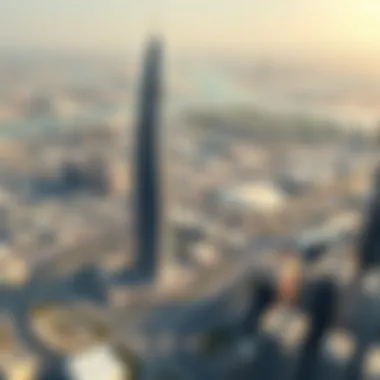
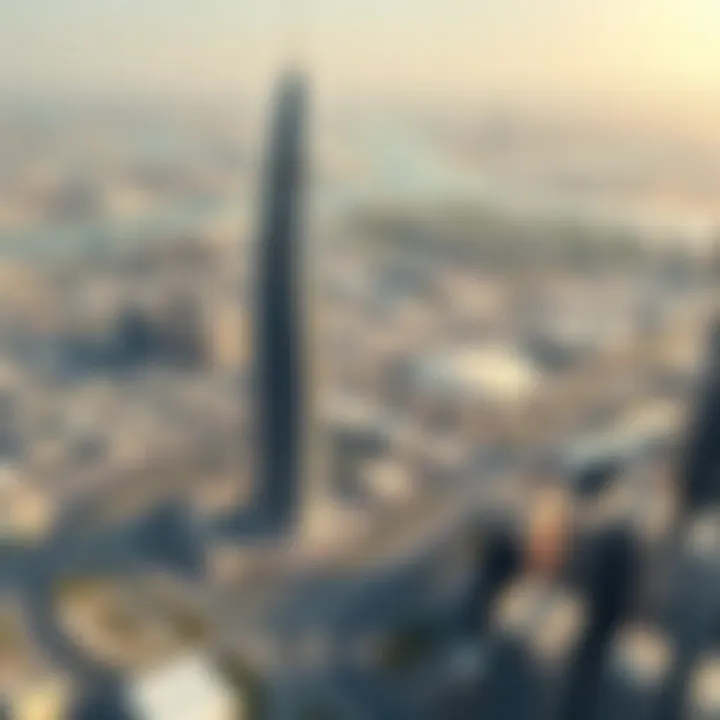
Some notable links include:
- Metro Red Line: Accessible from the nearest station, providing seamless connections to major districts like Downtown Dubai and Dubai Marina.
- Bus Services: Multiple bus routes run through the area, making it convenient for residents to access local amenities and reach further destinations without the need for a private vehicle.
- Taxis and Ride-Sharing: With an abundance of taxis and easy access to ride-sharing platforms like Uber, catching a ride is straightforward.
This multi-modal transport system not only enhances the accessibility of Sheikh Mohammed bin Rashid Tower but also enriches the overall commuting experience of its residents. The availability of diverse transport options reduces reliance on cars, ultimately contributing to a cleaner environment.
Road Infrastructure
In addition to public transport links, the road infrastructure around the Sheikh Mohammed bin Rashid Tower plays a significant role in facilitating easy access. The urban layout of Dubai is designed for efficiency, emphasizing wide roads and well-planned connectivity. Key aspects of the road infrastructure include:
- Major Highways: The tower is a stone's throw from significant thoroughfares such as Sheikh Zayed Road, which is one of the main arteries of Dubai. This allows quick access to both the city center and the greater metropolitan area.
- Dedicated Parking Facilities: Ample parking spaces are available at the tower, catering to residents, office workers, and visitors. This facility is essential in a city where vehicle ownership is prevalent.
- Accessibility for Pedestrians: Well-maintained sidewalks and pedestrian pathways link the tower with nearby amenities and community areas, promoting walking as a feasible option within the immediate vicinity.
"A well-connected property not only adds value but also elevates the living experience, enhancing both convenience and lifestyle."
The blend of public transit options and a robust road network creates an environment that fosters accessibility and mobility, firmly embedding the Sheikh Mohammed bin Rashid Tower within a larger, interconnected urban fabric. This strategic element not only appeals to prospective residents but also enhances the overall desirability of the location for investors exploring new opportunities in the Dubai real estate market.
Including these transportation insights not only illuminates the tower's strategic advantages but provides a comprehensive view of living in a place that connects you to the heart of Dubai effortlessly.
Comparative Analysis
Understanding the Sheikh Mohammed bin Rashid Tower in the context of other iconic skyscrapers worldwide provides invaluable insights into its architectural and cultural relevance. A comparative analysis serves as a lens to discern not only how this remarkable tower stands out but also how it aligns with global architectural trends, technological advancements, and economic implications. Investors and stakeholders benefit profoundly from this comparative approach, as it allows them to grasp market dynamics and positioning more clearly.
Comparison with Other Iconic Towers
When considering the Sheikh Mohammed bin Rashid Tower, it is essential to look at its peers. For example, the Burj Khalifa and the Taipei 101 are often referenced in the same breath. Each of these structures embodies specific cultural narratives, engineering feats, and aesthetic principles.
- Burj Khalifa: Often regarded as the tallest building in the world, it emphasizes verticality and light. The experience of standing at its base, gazing upwards, is nothing short of awe-inspiring. The sheer height of the Burj Khalifa offers parallels in ambition and aspiration when compared to Sheikh Mohammed bin Rashid Tower.
- Taipei 101: This tower is a prime example of how cultural context shapes architectural design. The traditional elements infused within its structure tell a story of resilience. Meanwhile, Sheikh Mohammed bin Rashid Tower's design elements reflect Middle Eastern aesthetics interwoven with modern influences.
- Willis Tower (formerly Sears Tower): This iconic building represents the power of corporate architecture in America. Its perspective in a bustling city contrasts with the serene elegance of the Sheikh Mohammed bin Rashid Tower, showing how the purpose of a tower can shape its design.
By drawing parallels and distinctions, we gain a multifaceted perspective of the Sheikh Mohammed bin Rashid Tower’s position within the skyline of Dubai and the world.
Differentiating Factors
The Sheikh Mohammed bin Rashid Tower distinguishes itself through several key attributes:
- Cultural Representation: The tower is not merely a building; it stands as a symbol of Dubai’s evolution. The architectural style combines futuristic elements with traditional motifs, making it a unique cultural landmark.
- Sustainability Features: Unlike some iconic skyscrapers that prioritize height over environmental considerations, Sheikh Mohammed bin Rashid Tower integrates green technologies. This dedication to sustainability may not be as pronounced in older towers, showcasing a modern awareness of environmental impact.
- Mixed-Use Design: The tower serves multiple purposes, which is becoming increasingly popular in urban architecture. This offers residential, commercial, and leisure spaces, satisfying a diverse segment of the population.
- Technological Innovation: The materials and engineering techniques employed herald a new era in construction. These advancements are not just about pushing limits but doing so intelligently and sustainably.
- Community Engagement: Surrounding infrastructure and public spaces have been thoughtfully designed to encourage interaction and community involvement, an aspect often overlooked in other monumental structures.
In summary, the Sheikh Mohammed bin Rashid Tower stands tall, not only in stature but also in its embodiment of cultural richness, architectural innovation, and community-centered design. As urban landscapes continue to evolve, the characteristics that set this tower apart will likely influence future architectural endeavors.
"Comparative analysis offers a path to understanding how local contexts influence global architectural trends."
This examination of the Sheikh Mohammed bin Rashid Tower alongside its iconic counterparts provides prospective investors and homeowners with the necessary knowledge to appreciate its unique standing on Dubai's skyline.
For further resources, visit:
- Burj Khalifa - Wikipedia
- Taipei 101 - Britannica
- Architecture and Sustainability
- Dubai Real Estate Insights on Reddit
- Public Transport Links - Dubai Government
This reflective lens not only enriches our understanding but also prepares potential stakeholders for informed decision-making in a vibrant real estate market.
The End
The Sheikh Mohammed bin Rashid Tower stands as a testament to Dubai's evolution, combining architectural brilliance with the vibrancy of a bustling urban center. In this article, we have explored the tower's significance across various dimensions, highlighting its role in defining Dubai’s skyline and offering insightful perspectives on its impact on property dynamics in the region.
Summary of Insights
Throughout our exploration, we delved into several key takeaways:
- Architectural Marvel: The tower not only reaches for the sky but embodies the innovative spirit of Dubai. Its design serves as a metaphor for reaching new heights, reinforcing the emirate’s image as a leader in modern architecture.
- Economic Catalyst: Integral to Dubai's real estate growth, the Sheikh Mohammed bin Rashid Tower influences the local market by attracting high-value investments and elevating property prices in its vicinity.
- Lifestyle Destination: By providing comprehensive amenities and services, the tower enhances the quality of life, making it a sought-after location for both residents and businesses. The surrounding infrastructure ensures seamless connectivity, enriching the community experience.
These insights underline the synergy between architectural sophistication and economic strategy, noting how such a landmark can catalyze broader transformations in urban settings.
Final Thoughts on Investment Potential
Investing in the Sheikh Mohammed bin Rashid Tower represents not just capital allocation but a strategic move into a thriving market. The following points emphasize its potential:
- High ROI Potential: Given Dubai's ongoing growth, investments in properties within proximity to iconic developments like this tower often yield significant returns. The desirability of the location among expatriates and business professionals enhances rental value and resale opportunities.
- Dynamic Market: The evolving nature of Dubai’s economy makes it a magnet for foreign investment. The government’s pro-business policies further bolster the attractiveness of properties in the area.
As property values continue to ascend, understanding the context and future outlook of the Sheikh Mohammed bin Rashid Tower is vital for discerning investors. This insight empowers stakeholders, enabling informed decisions within a fast-paced real estate landscape.
By synthesizing these insights, we underscore the importance of positioning oneself in a robust market with immense growth potential—building towards the future with a vision grounded in the present.
References and Further Reading
Exploring the components of the Sheikh Mohammed bin Rashid Tower deepens one’s understanding not just of the tower itself, but of Dubai’s broader narrative within the global landscape. Accurate and reliable references play a pivotal role in contextualizing the tower’s significance both architecturally and economically. Primarily, referencing credible sources ensures that the information presented throughout the article is robust, allowing readers to gauge the validity and depth of the insights shared.
Academic Publications
Academic publications provide a solid foundation for understanding the architectural and cultural relevance of the Sheikh Mohammed bin Rashid Tower. Many scholarly journals have dedicated their efforts to dissecting the various elements of modern architecture in the Gulf region, helping to reveal how such structures embody the aspirations of their locales. Not only do these documents present primary research findings, but they also furnish readers with theoretical analyses that can help clarify the line between mere construction and art.
- Benefits of Academic Works:
- They often provide peer-reviewed insights that are trustworthy.
- Many findings link historical contexts to present-day implications.
- They highlight innovation in engineering practices and sustainability initiatives adopted in the tower’s construction.
Many of these papers can be found in databases like JSTOR, or dedicated publications such as the International Journal of Architecture and The Architectural Review. Engaging with these resources will enrich the understanding of the tower's place in architectural history, revealing intricate narratives woven into its design and construction.
Online Resources
The breadth of knowledge surrounding the Sheikh Mohammed bin Rashid Tower continues to grow, with numerous online resources providing updated information on the tower’s features, developments, and impacts. Websites focused on real estate, architecture, and tourism can offer immediate insights and statistics that academic publications may lack in timeliness.
- Advantages of Online Information:
- Often includes real-time updates on market shifts and community events.
- Provides visual materials such as photographs and videos that enhance context and engagement.
- User-generated platforms like Reddit may reveal firsthand experiences from residents and visitors.
For the latest data, websites such as Dubai Tourism, Burj Khalifa's official site or Wikipedia give current insights while also leading to further references.
Engaging with both academic and online resources provides a richer perspective on the Sheikh Mohammed bin Rashid Tower, turning anecdotal knowledge into informed understanding.
Being well-versed in reliable references not only elevates one’s own insights but also enhances conversations with other stakeholders in the ever-evolving narrative of Dubai’s architectural landscape.











